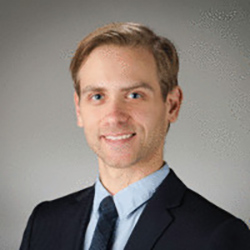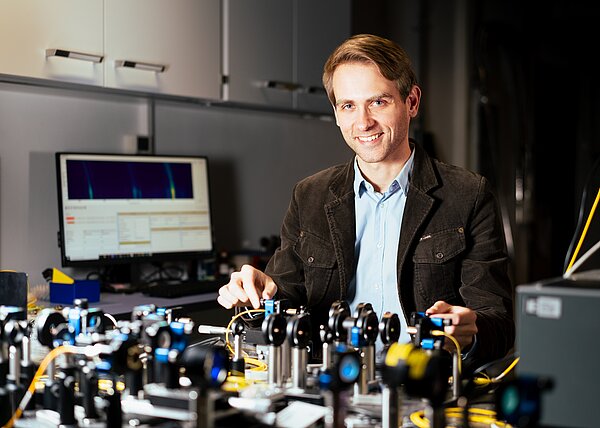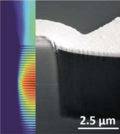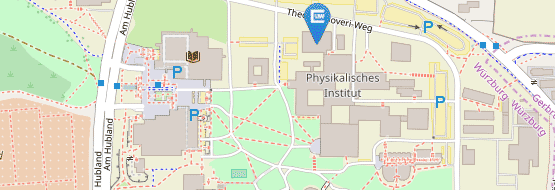Dr. Tobias Huber-Loyola
Dr. Tobias Huber-Loyola
University of Würzburg
Am Hubland

I am an independent junior research group leader, sponsored by the BMBF “Quantum Futur” initiative. In the research project “Qecs” (Quantum dots as deterministic Efficient photonic Cluster-state Sources) my team and me are developing a source for highly entangled states that can be used in measurement based quantum computing and in memory free quantum networks. I am PI and co-PI in several other international projects that are running at the chair with different research focusses, but all projects include quantum dots. Since 2018 I am at the Chair for Applied Physics at the Julius-Maximilians-Universität Würzburg, where I am also pursuing my habilitation in the field of experimental physics since 2021.
Study and development of quantum dots as single and entangled photon sources, quantum technologies for quantum communication and quantum computing, integrated quantum photonics, study and generation of non-classical and non-Gaussian states of light, light-matter interaction in weakly coupled systems, spin-photon interaction, hybrid quantum systems, frequency conversion, technology and design of microcavities
Current projects
We are realizing single and entangled photon sources based on semiconductor quantum dots. The quantum dots are grown by our excellent growth team and are usually embedded into nanophotonic cavities for enhanced light extraction. In this context, we are working on highly entangled photon states for quantum computing and quantum communication, frequency conversion of single photons from quantum dots, optimal placement of quantum dots into nanophotonic devices, optimization of nanophotonic devices, fiber coupling of single photons for networking applications, as well as fundamental aspects of light-matter coupling.
As Bachelor and Master thesis we offer sub-topics that are relevant for running projects (within the above-mentioned research scope) and thus this topics change frequently. An example could be “Hyperspectral imaging of quantum dots for placement in nanophotonic cavities” or “Investigation of lifetime-suppression of quantum dots in an optimized planar cavity”.
Master and Bachelor theses can be started at any time, there are always interesting topics available (the two mentioned above are only examples). The first contact is via email. Then, in a personal meeting, we will discuss possible research topics and personal research interests.
Since 2022
Independent Junior Research Group Leader in the BMBF “Quantum Futur” initiative, University of Würzburg, Chair for Applied Physics
2018-2021
Group Leader for “Spin-Photon interactions” and “Spectroscopy”, University of Würzburg, Chair for Applied Physics
2016 – 2018
Post-Doctoral Fellow, Joint Quantum Institute, University of Maryland and National Institute of Standards and Technology, USA
2012 – 2016
PhD, Department of Experimental Physics, Universität Innsbruck, Austria, supervised by Prof. Gregor Weihs
2009 – 2011
MSc., University of Innsbruck, Austria, supervised by Prof. Gregor Weihs
2008 – 2009
BSc., University of Innsbruck, Innsbruck, Austria, supervised by Prof. Gregor Weihs
2006 – 2008
Diploma program in Physics, University of Innsbruck, Innsbruck, Austria – changed to BSc. Program
2006 – 2008
Diploma program in art, Instrumental study of Viola, Tiroler Landeskonservatorium Innsbruck, Innsbruck, Austria (unfinished)
SS22
Lab course Physikalisches Praktikum im Nebenfach Physik
WS21/22
Exercise class Optik- und Quantenphysik 1
SS21
Lab course Physikalisches Praktikum A Lehramt (Mechanik, Wärme, Elektromagnetismus)
Lab course Physikalisches Praktikum A für Studierende Physik, Nanostrukturtechnik, Mathematische Physik, Luft- und Raumfahrtinformatik sowie Anwendungsfach Physik im Bachelor Mathe und Computational Mathematics (Mechanik, Wärme, Elektromagnetismus)
Exercise class Fortgeschritte Fehlerrechnung und computergestütztes Arbeiten
WS20/21
Exercise class Vorkurs Mathematik für Studierende des ersten Fachsemesters (MINT-Vorkurs der Physik - Rechenmethoden)
Plug‐and‐Play Fiber‐Coupled Quantum Dot Single‐Photon Source via Photonic Wire Bonding
M. de Gregorio, S. Yu, D. Witt, B. Lin, M. Mitchell, Ł. Dusanowski, C. Schneider, L. Chrostowski, T. Huber-Loyola, S. Höfling, J. F. Young, and A. Pfenning
Adv. Quantum Technol. 7 (2024), DOI: 10.1002/qute.202300227
Postfabrication Tuning of Circular Bragg Resonators for Enhanced Emitter-Cavity Coupling
T. M. Krieger, C. Weidinger, T. Oberleitner, G. Undeutsch, M. B. Rota, N. Tajik, M. Aigner, Q. Buchinger, C. Schimpf, A. J. Garcia, S. F. Da Covre Silva, S. Höfling, T. Huber-Loyola, R. Trotta, and A. Rastelli
ACS Photonics 11, 596 (2024), DOI: 10.1021/acsphotonics.3c01480
Polarized and Unpolarized Emission from a Single Emitter in a Bullseye Resonator
G. Peniakov, Q. Buchinger, M. Helal, S. Betzold, Y. Reum, M. B. Rota, G. Ronco, M. Beccaceci, T. M. Krieger, S. F. C. Da Silva, A. Rastelli, R. Trotta, A. Pfenning, S. Höfling, and T. Huber-Loyola
Laser Photonics Rev. (2024), DOI: 10.1002/lpor.202300835
A source of entangled photons based on a cavity-enhanced and strain-tuned GaAs quantum dot
M. B. Rota, T. M. Krieger, Q. Buchinger, M. Beccaceci, J. Neuwirth, H. Huet, N. Horová, G. Lovicu, G. Ronco, S. F. Da Covre Silva, G. Pettinari, M. Moczała-Dusanowska, C. Kohlberger, S. Manna, S. Stroj, J. Freund, X. Yuan, C. Schneider, M. Ježek, S. Höfling, F. Basso Basset, T. Huber-Loyola, A. Rastelli, and R. Trotta
eLight 4, 13 (2024), DOI: 10.1186/s43593-024-00072-8
Ultra-low density and high performance InAs quantum dot single photon emitters
C. Shang, M. de Gregorio, Q. Buchinger, M. Meinecke, P. Gschwandtner, A. Pfenning, T. Huber-Loyola, S. Höfling, and J. E. Bowers
APL Quantum 1 (2024), DOI: 10.1063/5.0209866
Deterministic storage and retrieval of telecom light from a quantum dot single-photon source interfaced with an atomic quantum memory
S. E. Thomas, L. Wagner, R. Joos, R. Sittig, C. Nawrath, P. Burdekin, I. M. de Buy Wenniger, M. J. Rasiah, T. Huber-Loyola, S. Sagona-Stophel, S. Höfling, M. Jetter, P. Michler, I. A. Walmsley, S. L. Portalupi, and P. M. Ledingham
Sci. Adv., eadi7346 (2024), DOI: 10.1126/sciadv.adi7346
Signatures of the Optical Stark Effect on Entangled Photon Pairs from Resonantly Pumped Quantum Dots
F. Basso Basset, M. B. Rota, M. Beccaceci, T. M. Krieger, Q. Buchinger, J. Neuwirth, H. Huet, S. Stroj, S. F. Da Covre Silva, G. Ronco, C. Schimpf, S. Höfling, T. Huber-Loyola, A. Rastelli, and R. Trotta
Phys. Rev. Lett. 131, 166901 (2023), DOI: 10.1103/PhysRevLett.131.166901
2023 roadmap for materials for quantum technologies
C. Becher, W. Gao, S. Kar, C. D. Marciniak, T. Monz, J. G. Bartholomew, P. Goldner, H. Loh, E. Marcellina, K. E. J. Goh, T. S. Koh, B. Weber, Z. Mu, J.-Y. Tsai, Q. Yan, T. Huber-Loyola, S. Höfling, S. Gyger, S. Steinhauer, and V. Zwiller
Mater. Quantum. Technol. 3, 12501 (2023), DOI: 10.1088/2633-4356/aca3f2
Optical properties of circular Bragg gratings with labyrinth geometry to enable electrical contacts
Q. Buchinger, S. Betzold, S. Höfling, and T. Huber-Loyola
Appl. Phys. Lett. 122, 111110 (2023), DOI: 10.1063/5.0136715
Single-Photon Source in a Topological Cavity
J. Jurkat, S. Klembt, M. de Gregorio, M. Meinecke, Q. Buchinger, T. H. Harder, J. Beierlein, O. A. Egorov, M. Emmerling, C. Krause, C. Schneider, T. Huber-Loyola, and S. Höfling
Nano Lett. 23, 820 (2023), DOI: 10.1021/acs.nanolett.2c03693
Purcell‐Enhanced Single‐Photon Emission in the Telecom C‐Band
J. Kaupp, Y. Reum, F. Kohr, J. Michl, Q. Buchinger, A. Wolf, G. Peniakov, T. Huber-Loyola, A. Pfenning, and S. Höfling
Adv. Quantum Technol. 6 (2023), DOI: 10.1002/qute.202300242
Strain‐Free GaSb Quantum Dots as Single‐Photon Sources in the Telecom S‐Band
J. Michl, G. Peniakov, A. Pfenning, J. Hilska, A. Chellu, A. Bader, M. Guina, S. Höfling, T. Hakkarainen, and T. Huber-Loyola
Adv. Quantum Technol. 6 (2023), DOI: 10.1002/qute.202300180
Monolithic high contrast grating on GaSb/AlAsSb based epitaxial structures for mid-infrared wavelength applications
A. Schade, A. Bader, T. Huber, S. Kuhn, T. Czyszanowski, A. Pfenning, M. Rygała, T. Smołka, M. Motyka, G. Sęk, F. Hartmann, and S. Höfling
Opt. Express 31, 16025 (2023), DOI: 10.1364/OE.487119
Numerical optimization of single-mode fiber-coupled single-photon sources based on semiconductor quantum dots
L. Bremer, C. Jimenez, S. Thiele, K. Weber, T. Huber, S. Rodt, A. Herkommer, S. Burger, S. Höfling, H. Giessen, and S. Reitzenstein
Opt. Express 30, 15913 (2022), DOI: 10.1364/OE.456777
Optical charge injection and coherent control of a quantum-dot spin-qubit emitting at telecom wavelengths
Ł. Dusanowski, C. Nawrath, S. L. Portalupi, M. Jetter, T. Huber, S. Klembt, P. Michler, and S. Höfling
Nat. Commun. 13, 748 (2022), DOI: 10.1038/s41467-022-28328-2
Technological implementation of a photonic Bier-Glas cavity
J. Jurkat, M. Moczała-Dusanowska, M. Arentoft Jacobsen, A. Predojević, T. Huber, N. Gregersen, S. Höfling, and C. Schneider
Phys. Rev. Mater. 5, 64603 (2021), DOI: 10.1103/PhysRevMaterials.5.064603
Optomechanical tuning of the polarization properties of micropillar cavity systems with embedded quantum dots
S. Gerhardt, M. Moczała-Dusanowska, Ł. Dusanowski, T. Huber, S. Betzold, J. Martín-Sánchez, R. Trotta, A. Predojević, S. Höfling, and C. Schneider
Phys. Rev. B 101, 245308 (2020), DOI: 10.1103/PhysRevB.101.245308
Filter-free single-photon quantum dot resonance fluorescence in an integrated cavity-waveguide device
T. Huber, M. Davanço, M. Müller, Y. Shuai, O. Gazzano, and G. S. Solomon
Optica 7, 380 (2020), DOI: 10.1364/OPTICA.382273
Strain-Tunable Single-Photon Source Based on a Circular Bragg Grating Cavity with Embedded Quantum Dots
M. Moczała-Dusanowska, Ł. Dusanowski, O. Iff, T. Huber, S. Kuhn, T. Czyszanowski, C. Schneider, and S. Höfling
ACS Photonics 7, 3474 (2020), DOI: 10.1021/acsphotonics.0c01465
Effects of resonant-laser excitation on the emission properties in a single quantum dot
O. Gazzano, T. Huber, V. Loo, S. V. Polyakov, E. B. Flagg, and G. S. Solomon
Optica 5, 354 (2018), DOI: 10.1364/OPTICA.5.000354
Hyperentanglement of Photons Emitted by a Quantum Dot
M. Prilmüller, T. Huber, M. Müller, P. Michler, G. Weihs, and A. Predojević
Phys. Rev. Lett. 121, 110503 (2018), DOI: 10.1103/PhysRevLett.121.110503
Interfacing a quantum dot with a spontaneous parametric down-conversion source
T. Huber, M. Prilmüller, M. Sehner, G. S. Solomon, A. Predojević, and G. Weihs
Quantum Sci. Technol. 2, 34016 (2017), DOI: 10.1088/2058-9565/aa7b65
A solid state source of photon triplets based on quantum dot molecules
M. Khoshnegar, T. Huber, A. Predojević, D. Dalacu, M. Prilmüller, J. Lapointe, X. Wu, P. Tamarat, B. Lounis, P. J. Poole, G. Weihs, and H. Majedi
Nat. Commun. 8, 15716 (2017), DOI: 10.1038/ncomms15716
Simultaneous, Full Characterization of a Single-Photon State
T. Thomay, S. V. Polyakov, O. Gazzano, E. Goldschmidt, Z. D. Eldredge, T. Huber, V. Loo, and G. S. Solomon
Phys. Rev. X 7, 41036 (2017), DOI: 10.1103/PhysRevX.7.041036
Coherence and degree of time-bin entanglement from quantum dots
T. Huber, L. Ostermann, M. Prilmüller, G. S. Solomon, H. Ritsch, G. Weihs, and A. Predojević
Phys. Rev. B 93, 201301 (2016), DOI: 10.1103/PhysRevB.93.201301
Effects of photo-neutralization on the emission properties of quantum dots
T. Huber, A. Predojević, G. S. Solomon, and G. Weihs
Opt. Express 24, 21794 (2016), DOI: 10.1364/OE.24.021794
Optimal excitation conditions for indistinguishable photons from quantum dots
T. Huber, A. Predojević, D. Föger, G. S. Solomon, and G. Weihs
New J. Phys. 17, 123025 (2015), DOI: 10.1088/1367-2630/17/12/123025
Polarization entangled photons from quantum dots embedded in nanowires
T. Huber, A. Predojević, M. Khoshnegar, D. Dalacu, P. J. Poole, H. Majedi, and G. Weihs
Nano Lett. 14, 7107 (2014), DOI: 10.1021/nl503581d
Time-bin entangled photons from a quantum dot
H. Jayakumar, A. Predojević, T. Kauten, T. Huber, G. S. Solomon, and G. Weihs
Nat. Commun. 5, 4251 (2014), DOI: 10.1038/ncomms5251
Efficiency vs. multi-photon contribution test for quantum dots
A. Predojević, M. Ježek, T. Huber, H. Jayakumar, T. Kauten, G. S. Solomon, R. Filip, and G. Weihs
Opt. Express 22, 4789 (2014), DOI: 10.1364/OE.22.004789
Quantum non-Gaussian Depth of Single-Photon States
I. Straka, A. Predojević, T. Huber, L. Lachman, L. Butschek, M. Miková, M. Mičuda, G. S. Solomon, G. Weihs, M. Ježek, and R. Filip
Phys. Rev. Lett. 113, 223603 (2014), DOI: 10.1103/PhysRevLett.113.223603
Measurement and modification of biexciton-exciton time correlations
T. Huber, A. Predojević, H. Zoubi, H. Jayakumar, G. S. Solomon, and G. Weihs
Opt. Express 21, 9890 (2013), DOI: 10.1364/OE.21.009890
Deterministic photon pairs and coherent optical control of a single quantum dot
H. Jayakumar, A. Predojević, T. Huber, T. Kauten, G. S. Solomon, and G. Weihs
Phys. Rev. Lett. 110, 135505 (2013), DOI: 10.1103/PhysRevLett.110.135505








